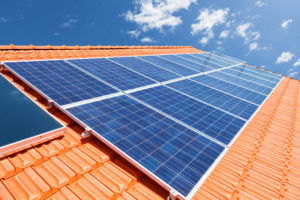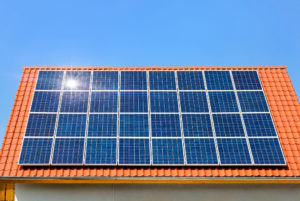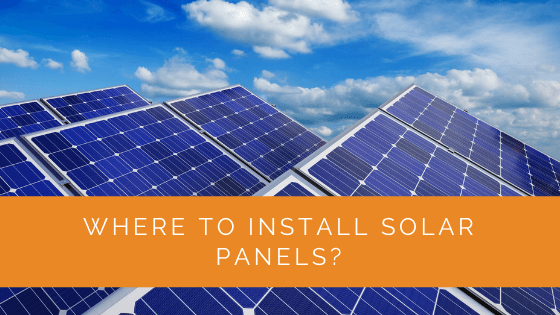The location of a solar panel is the most important element that determines how much solar energy the panels receive. So, you must place your newly purchased solar panels in a location where they receive a lot of sunlight.
Typically, you can install solar panels on the ground or the roof. When you decide to install solar panels in your home, many things go into consideration.
With the help of this article, we will help you understand what factors you need to consider and where you should install your solar panels. Continue reading to find out!
Contents
- 1 Key Takeaways
- 2 What Affects The Energy You Receive From Solar Panels?
- 3 Roof Mounting Or Ground Mounting – Which Is Better?
- 4 Which Direction Should Solar Panels Ideally Face?
- 5 Why Do Solar Panels Work Best When Facing South?
- 6 Which Is The Best Roof Shape For Solar Panels?
- 7 Which Is The Best Roof Style For Solar Panels?
- 8 Is Consultation Necessary For Installing Solar Panels?
- 9 Case Study: Optimizing Solar Panel Placement for Maximum Efficiency
- 10 Expert Insights From Our Solar Panel Installers About Where to Install Solar Panels
- 11 Experience Solar Excellence with Us!
- 12 Conclusion
Key Takeaways
- Solar panel placement is crucial for maximizing energy generation. You can install solar panels on the ground or the roof, but several factors, including the roof’s pitch and shading, must be considered.
- The ideal direction for solar panels is south, as it ensures they receive maximum sunlight throughout the day. East or west-facing panels can also work well, but north-facing panels are less efficient due to increased shading.
- The best roof shape for solar panels is one with ample space, allowing panels to face south, west, or east. Consulting a professional for installation is advisable to optimize solar energy utilization.
What Affects The Energy You Receive From Solar Panels?
Multiple factors are in play when you install a solar panel on the roof of your home. Below, we have collated a list of certain elements that might help you decide where to install the solar panels.
The Pitch of The Roof
If you’re wondering what we mean by the pitch of the roof, it refers to the angle of the roof. If you have a flat or a steep roof at your home, you will need to put in the extra work to install solar panels at the perfect angle.
However, if your home’s rooftop is nothing special and lies within a standard design, the installation will be comparatively easier. You won’t need any special equipment. This, consequently, gives you solar panels at a cheaper rate.
The pitch angle you should root for is traditionally between 30 and 45 degrees. A solar panel at the perfect angle contributes to the increase in the overall solar energy that you receive. It can then harness solar energy efficiently.

Ballasted Mounts and Flat Roofs
From the information given above, you may have inferred that having a flat roof might be the solution to all your problems while installing a solar panel. However, if you have a flat roof, you will require a different mounting system.
Ballasted mounts do the best job at holding solar panels in place on homes with flat roofs. Furthermore, these mounts also enable the solar panel to tilt by the flexibility that comes along.
Ballasted mounts provide you with a racking set. This set gives the perfect angle to your solar panel as per the latitude of your home. These racking sets are held together by cement blocks.
Shade isn’t always good
Solar panels operate on the energy received from the sun. So, solar panels should be exposed to as much sunlight as possible. Objects that cast a shadow over the most suitable locations make it difficult to install solar panels.
Roof Mounting Or Ground Mounting – Which Is Better?
If you drive through a residential neighborhood with blue or black solar panels, you will notice that almost all of them are roof-mounted. This is because rooftops generally offer a wide variety of mounting options and provide maximum benefits when it comes to sunlight.
So, the top of any home or building appears to be the best place for mounting solar panels as they are less likely to receive shade from other objects on the roof. This allows them to work effectively.
Nevertheless, it may so happen that your roof cannot escape the shade from nearby objects, or the roof can be shaped in a manner where it’s impossible to mount solar panels.
Meaning to say that not all roofs are suitable for solar panel installation, especially roofs made from clay tiles. So, if you have an oddly shaped roof, the best option for you is to opt for a ground-mounted installation.
If you have plenty of space available, ground-mounted solar panels will enable you to adjust the panels manually. This helps you receive the maximum amount of solar power with each season.
Additionally, it is easier to clean and maintain solar panels when they are on the ground.
It is imperative to mention that ground-mounted solar panels cost higher than rooftop solar panels. This is because the material required for their installation is more expensive than roof-mounted solar panels.
Ground-mounted solar panels necessitate excavation and building a foundation that increases the solar panels’ overall cost and installation. However, if there is no other option for you to mount the solar panels on the roof, this might be the best option for you.
So, even though roof-mounted solar panels are the best option for any building, ground-mounted solar panels are also a viable option that helps you receive solar energy. These mounting systems are meant to ease your solar journey depending on the kind of roof you have.
Which Direction Should Solar Panels Ideally Face?
After considering the factors given above, let’s now learn about the ideal direction that optimizes the energy received from solar panels. As we already know, the sun rises in the east and sets in the west.
So, we need to place the solar panels in a manner in which they always face the sun and don’t get blocked by any shadows. To ensure this, you need to install your solar panels in the south direction.
If your solar panels face south, you will receive a large amount of energy because there will never be a shadow cast over them. Moreover, south-facing solar panels never see a day without the sun!
If this is not possible for you, there’s nothing to worry about. You can also install the solar panels in a manner where they face east or west directions. That is also likely to give you plenty of energy.
All sides except north work in solar panel placement. North-facing solar panels do not work efficiently because objects that face north receive more shade. Thus, it reduces the amount of energy they receive.

Why Do Solar Panels Work Best When Facing South?
After what we just told you, you are probably wondering why south is the best direction for solar panels. Correct? The answer to the question given above is quite simple. The earth is a sphere. So, sunlight reaches all locations at different angles.
The sun rises in the east, and so, solar panels facing east are likely to receive sunlight in the morning. Thus, they are at an optimum level only in the morning. As the sun sets in the west, solar panels facing that direction are optimum in the afternoon.
However, south-facing solar panels receive sunlight throughout the day if no shadow is cast on them. If you live in the northern hemisphere, your solar panels work best when they are facing south.
Which Is The Best Roof Shape For Solar Panels?
The shape of your house is one of the most important things that is going to determine whether your solar panels will work or not. So, if you’re wondering what the ideal roof shape is, we are here to tell you all about it.
The ideal roof shape for solar panels is a roof with lots of space that allows the solar panels to face south, west, or east. Typically, a residential solar panel is about 65 by 39 inches big. This is likely to take up 17.5 square feet of space for each solar panel.
Traditionally, roofs are known to have at least 3000 square feet of space. So, if no object casts shade on your roof, you can install up to 171 solar panels on your roof. Of course, the pitch, time of day, and other factors mentioned above come into play.
However, in an ideal scenario with the perfect roof shape, you are likely to receive lots of energy in any direction except the north.
Which Is The Best Roof Style For Solar Panels?
As you may already know, there are many roofing styles available for different homes. Similarly, many different pitches and angles complement your roof in various ways for solar panel installation.
The most commonly used roofs which aid solar panel installation include wood, slate, copper, rubber, metal, wood, tile, and asphalt. If you’re looking for that ballasted mounting on the roof, then it is necessary for you to give due consideration to the age of your roof.
Is Consultation Necessary For Installing Solar Panels?
As you may have noticed, choosing a place for your solar panels requires a lot of speculation with regard to the angle, pitch, and latitudes at which your place receives the sunlight. Therefore, it might be a difficult decision to make.
So, it is best to consult a professional regarding what works best for your home or building, as that will help you use the energy from solar panels optimally. Anything could go wrong with one single step.
To avoid this, it is advised that you seek professional help regarding the installation of solar panels.

Case Study: Optimizing Solar Panel Placement for Maximum Efficiency
Background
At Solar Panels Network USA, we frequently encounter the challenge of optimizing solar panel placement to maximize energy generation. One of our recent projects exemplifies how strategic planning and professional expertise can lead to successful solar installations.
Project Overview
A residential client approached us with the goal of installing solar panels on their home. Their primary concern was ensuring the panels received the maximum possible sunlight throughout the day, despite having a partially shaded roof.
Implementation
Our first step was conducting a thorough site assessment, including evaluating the roof’s pitch, potential shading from nearby trees and buildings, and the overall roof area available for panel installation. Using advanced tools, we mapped the solar potential of different sections of the roof, identifying optimal spots for panel placement.
We decided to use a combination of roof-mounted and ground-mounted solar panels. The roof-mounted panels were installed on the south-facing side of the house, where they would receive direct sunlight throughout the day. To address the shaded areas and to increase overall solar capacity, additional panels were mounted on the ground in the spacious backyard, positioned at an optimal tilt using ballasted mounts.
Results
The dual approach of combining roof and ground-mounted panels maximized the home’s solar energy production. The roof-mounted panels provided consistent energy output during peak sunlight hours, while the ground-mounted panels allowed for easy adjustments and maintenance, ensuring optimal performance year-round.
Our client reported a significant reduction in their electricity bills and an overall increase in energy independence. The installation also improved the home’s energy efficiency rating, contributing to its long-term value.
Summary
This case study highlights the importance of professional consultation and strategic planning in solar panel installations. By considering factors such as roof pitch, shading, and available space, Solar Panels Network USA successfully optimized solar energy production for the client, demonstrating our commitment to delivering efficient and effective solar solutions.
Expert Insights From Our Solar Panel Installers About Where to Install Solar Panels
Ensuring optimal placement for solar panels requires a detailed understanding of various factors, such as roof pitch and shading. A roof with a pitch angle between 30 and 45 degrees typically provides the best efficiency for solar energy capture.
Senior Solar Installer
The decision between roof-mounted and ground-mounted solar panels depends heavily on the unique characteristics of your property. Roof mounts are generally more cost-effective and less prone to shading issues, whereas ground mounts offer flexibility in adjustment for seasonal changes.
Lead Installation Technician
Facing solar panels south ensures maximum sunlight exposure throughout the day, significantly enhancing energy production. If a south-facing installation isn’t feasible, east or west-facing panels are viable alternatives that still provide substantial energy benefits.
Solar Energy Specialist
Experience Solar Excellence with Us!
Trust in Solar Panels Network USA, where our seasoned experts deliver top-quality solar solutions for homes and businesses nationwide. With a legacy of countless successful installations and a commitment to sustainable energy, we’re your reliable partner in the solar journey. Ready for a brighter, eco-friendly future? Call us now at (855) 427-0058 and harness the power of the sun!
Conclusion
Now that you know quite a lot about the factors that affect solar panels and their functioning, we hope you can make a wise decision about where to install solar panels. As you saw above, many elements play a huge role in the optimization of energy through solar panels.
You need to know the correct angles and the direction. Most importantly, you should get rid of those objects that cast a shadow on your solar panels. Solar panels work best when they face south because they receive sunlight all day long.
Most people install solar panels on the roofs as compared to the ground installation of solar panels. The reason behind this is extremely simple – more altitude gives more sunlight.
Solar panels provide you with the best and most efficient form of energy. So, get started on picking the best place for your solar panels and enjoy the plethora of energy throughout the day!
About the Author
Solar Panels Network USA stands at the forefront of solar energy solutions, driven by a team of seasoned solar engineers and energy consultants. With over decades of experience in delivering high-quality solar installations and maintenance, we are committed to promoting sustainable energy through customer-centric, tailored solutions. Our articles reflect this commitment, crafted collaboratively by experts to provide accurate, up-to-date insights into solar technology, ensuring our readers are well-informed and empowered in their solar energy decisions.

